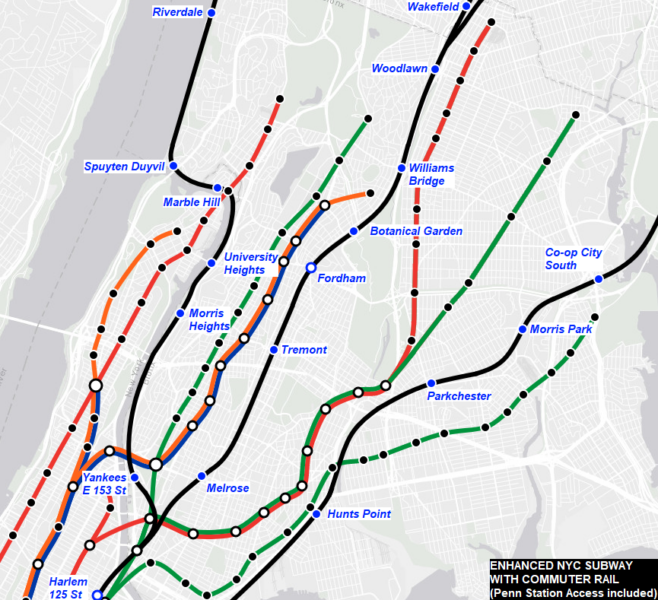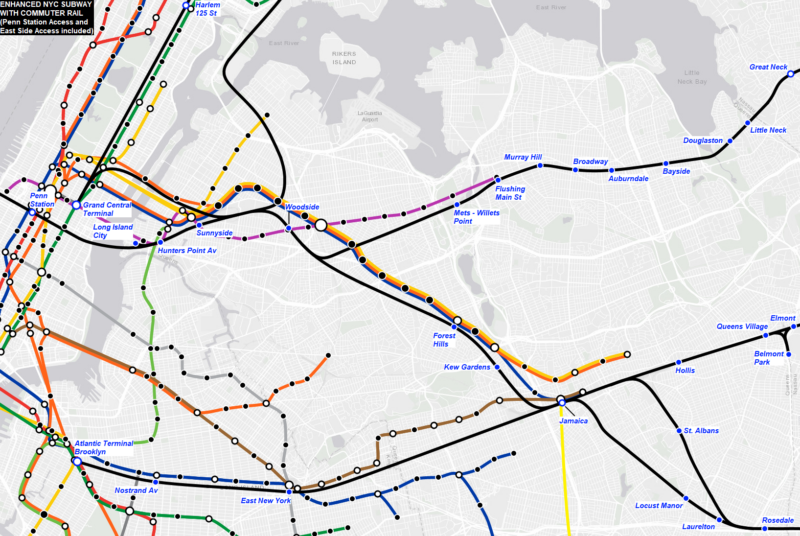UPDATE (03.13.2022): Images now reflect v0.7.0 of the enhanced NYC subway.
You might’ve noticed that I’ve temporarily unpublished most of my subway extension posts. The main reason is my evolving stance on regional rail – a hot topic in the transport advocacy space and on Transit Twitter. Find out what this means for NYTIP on this edition of the INSIDER!
When I first started drafting NYTIP, I gave thought to regional rail integration in a vain similar to the T-REX plan proposed by the Regional Plan Association (RPA, linked above), but with some differences. While it’s tempting to use existing commuter rail infrastructure to replace select subway extensions, the simple fact is regional rail cannot replace subway extensions without a key element – predictability.
Making regional rail predictable requires two key elements – fare parity and regularity.
Fare Parity
Put simply, fare parity – or fare rationalization – sets regional rail fares within the urban core equal to the prevailing local transit fare. For NYC proper, this is the $2.75 subway and bus fare (or alternatively, the $3.00 single-ride ticket fare). So long as regional rail charges semi-premium (i.e. CityTicket) fares or the existing super-premium fares, it cannot truly “replace” subway extensions.
Equalizing fares alone does not achieve fare parity, however. MTA’s commuter rail systems – Metro-North Railroad (MNR) and Long Island Rail Road (LIRR) – charge different fares based on time of day. Typically, a higher fare (the “peak” fare) applies during rush hours and a lower “off peak” fare applies at other times. To make fare regimes predictable, the same fare should apply regardless of time-of-day. Under NYTIP, therefore, peak fares go away; this should encourage ridership both in the urban core (via fare rationalization), and in the suburbs and exurbs via lower off-peak fares. OMNY integration could further encourage ridership by simplifying payment across modes.
Regularity
Regularity refers to a predictable service regime. Rather than departures at specific times, NYTIP prescribes departures at specific intervals. The RPA proposes a baseline headway of 10 minutes (6 trains per hour, or TPH) during peak hours and 15 minutes (4 TPH) during off-peak hours for trains within the urban core; on certain segments, such as MNR’s Harlem line in The Bronx or the LIRR west of Bellerose, branch lines run together on four-track trunk lines, making subway-like frequencies possible at the local stops. Express services from the suburbs or exurbs could then run in conjunction with the baseline service; one could then overlay peak-only services where capacity permits.
NYTIP is agnostic on the peak services one could overlay atop baseline local and express service, but regional rail improvements should make such possible.
Regularly scheduled service at frequent intervals should encourage significant ridership, offsetting the cost of reduced fares, labor, and system upgrades (such as added rolling stock and power upgrades) required to operate the increased service.
A New Approach to Subway Extensions under NYTIP
With fare parity and regularity, regional rail becomes a viable alternative to some subway extensions. When examining existing commuter rail infrastructure in NYC, certain regions stand out:
[Figs. 1, 2] The enhanced NYC Subway with commuter rail infrastructure included. Images include East Side Access and Penn Station Access. Created using Brand New Subway and image editing apps.
In The Bronx, regional rail could fill several gaps in rapid transit coverage; in Queens, it could fill gaps in NE and SE Queens. Regional rail could serve the same catchment area as popular candidates for subway extensions, such as 3rd Avenue in The Bronx and Northern Boulevard in Queens. Existing rail infrastructure also complements the Lexington Avenue, Flushing, Queens Boulevard, Fulton Street, and Jamaica Avenue corridors. Note that the images show what’s possible with existing infrastructure; when combined with targeted infill stations and other investments (future posts), a regional rail network would make rapid transit accessible to many more thousands of people.
Consequently, my new approach to subway extensions under NYTIP takes regional rail into account. Key subway extension goals include increased system capacity, accessibility, connectivity, and ridership. As I publish new posts on regional rail and republish updated subway extension posts, you will see the new vision come together. Stay tuned!


